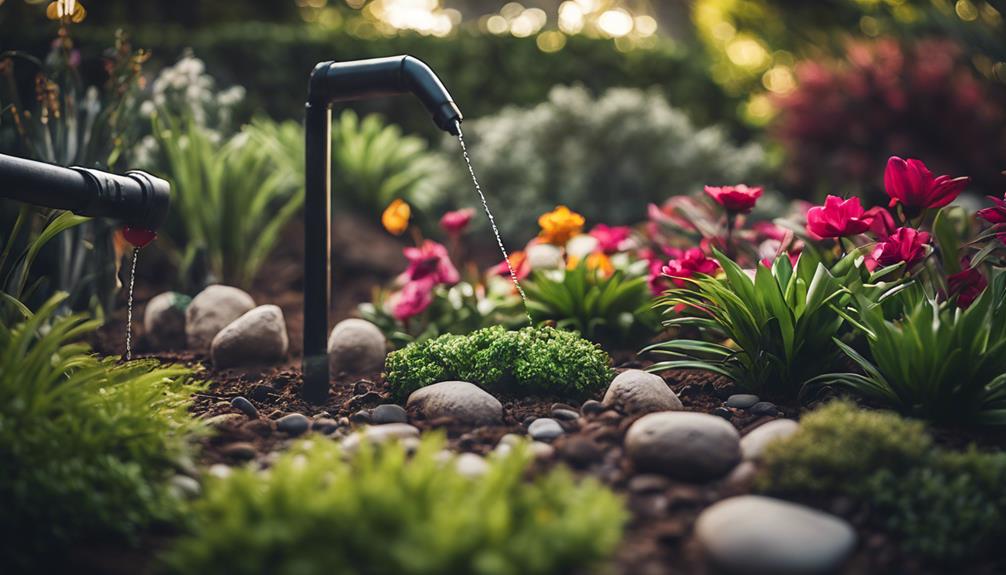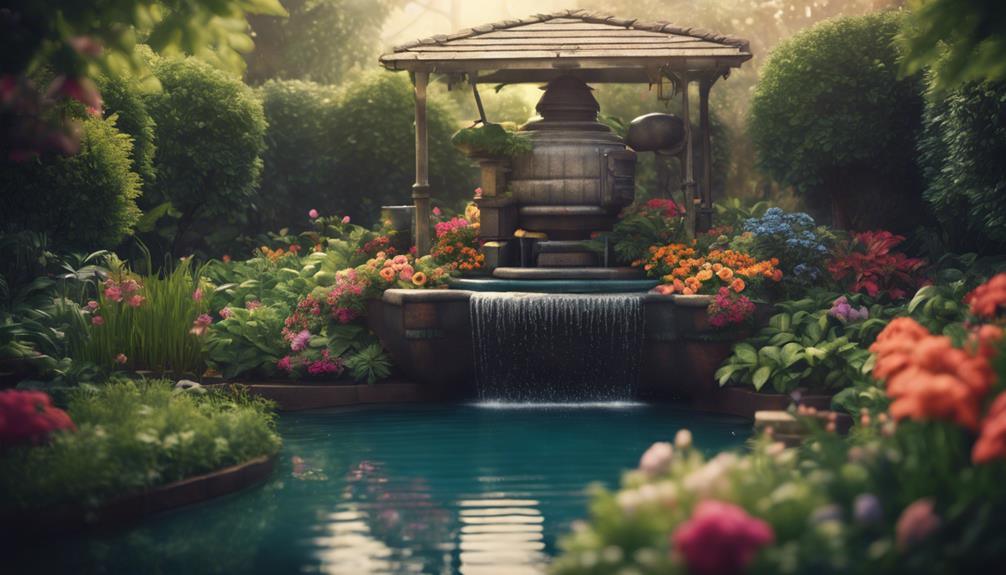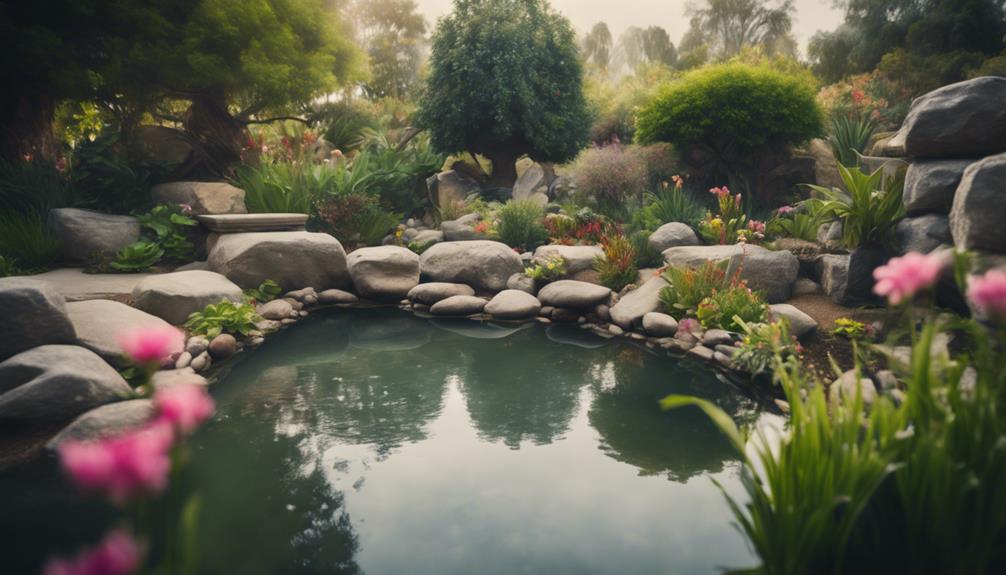You can minimize water loss in your garden oasis by adopting efficient watering techniques. Start by applying a 2-3 inch layer of organic mulch to retain moisture and regulate soil temperature. Choose drought-tolerant plants and group them by water needs to optimize irrigation. Adjust your watering schedule according to weather conditions and plant health. Consider installing drip irrigation systems or soaker hoses, which can cut water loss by up to 50%. Regularly check soil moisture and maintain a healthy soil structure to reduce water waste. By implementing these strategies, you'll be well on your way to creating a sustainable and thriving garden oasis – and there's more to discover.
Table of Contents
Key Takeaways
- Apply a 2-3 inch layer of organic mulch to retain moisture, suppress weeds, and regulate soil temperature in your garden oasis.
- Choose drought-tolerant plants adapted to local climates to reduce supplemental water requirements and minimize water loss.
- Implement efficient irrigation systems like drip irrigation, soaker hoses, and rain sensors to optimize watering schedules and reduce waste.
- Regularly check soil moisture to avoid overwatering and create a personalized watering schedule based on weather forecasts and plant needs.
- Harvest and reuse rainwater to minimize evaporation, retain moisture in soil, and promote sustainable water management in your garden oasis.
Efficient Watering Techniques
By adopting efficient watering techniques, you can substantially reduce water loss in your garden, ensuring that every drop counts.
One vital step is to water deeply but infrequently, encouraging drought-tolerant plants to develop strong root systems. This approach minimizes water consumption and promotes healthy plant growth.
To optimize irrigation efficiency, check soil moisture regularly to avoid overwatering. Create a personalized watering schedule based on weather forecasts and plant needs, adjusting as needed.
In addition, focus on watering the soil rather than the leaves to prevent evaporation and runoff. By doing so, you'll reduce water loss and direct it where it's needed most.
Additionally, consider grouping plants with similar watering needs together, making it easier to cater to their requirements.
Mulch and Compost Benefits
As you work to minimize water loss in your garden, you're likely aware that soil temperature and water retention capacity play critical roles.
By incorporating mulch and compost into your garden routine, you'll be able to regulate soil temperature and boost water retention, leading to a more efficient use of this precious resource.
Now, let's take a closer look at how these organic amendments can help you achieve a more water-conscious garden.
Soil Temperature Regulation
Two essential components of soil temperature regulation are mulch and compost, which work together to create a stable environment that fosters healthy plant growth and minimizes water loss.
By applying a 2-3 inch layer of organic mulch, you can reduce soil temperature fluctuations by up to 50%, creating a more stable environment for roots to grow. In hot climates, mulch can reduce soil temperature by up to 10°F (5.5°C), reducing water loss through evaporation and improving plant water uptake.
Compost adds organic matter to the soil, increasing its water-holding capacity, reducing soil temperature extremes, and providing nutrients for plants to grow.
By moderating soil temperature, mulch and compost can also reduce soil moisture loss, allowing plants to thrive with less water and reducing the need for frequent irrigation. This, in turn, helps prevent soil erosion and promotes healthy soil structure, which is essential for robust root growth.
Water Retention Capacity
Mulch and compost substantially enhance your garden's water retention capacity, allowing you to conserve this precious resource and create a more resilient ecosystem.
By incorporating these organic wonders into your garden design, you'll be amazed at the difference they make.
A 2-3 inch layer of mulch, for instance, can retain up to 25% more water in the soil, reducing evaporation and the need for frequent irrigation.
Compost, on the other hand, enriches the soil with organic matter, increasing its water retention capacity by up to 20%.
This means that during drought conditions, your plants will thrive, thanks to the additional moisture levels retained in the soil.
In fact, a 1% increase in organic matter can retain an astonishing 16,000 gallons of water per acre!
Soil Moisture Monitoring
As you focus on minimizing water loss in your garden, it's essential to understand that soil conditions matter, and checking moisture levels is key.
You'll want to develop a routine of monitoring soil moisture to optimize your watering schedules and prevent overwatering or underwatering.
Soil Conditions Matter
By grasping the nuances of soil moisture monitoring, you can discover the secret to optimizing your garden's watering schedule, thereby avoiding the pitfalls of overwatering and underwatering that can devastate your plants.
The type of soil you have plays a significant role in determining the ideal moisture level. For instance, sandy soils drain quickly, while clay soils retain water longer. Understanding your soil type helps you tailor your watering schedule to its unique needs.
A moisture meter can give you an accurate reading of your soil's moisture level, ensuring you're not over- or under-watering. Mulch can also help retain soil moisture, reducing evaporation and runoff.
By monitoring soil moisture, you'll be able to identify areas with poor drainage or waterlogging, making adjustments to improve soil structure and prevent water loss. This attention to detail won't only conserve water but also boost plant health and promote drought-tolerant growth.
Check Moisture Levels
Checking soil moisture levels regularly is essential to fine-tuning your watering schedule, and there are several ways to do it accurately. By monitoring soil moisture, you'll be able to adjust your watering schedule to prevent overwatering or underwatering, reducing water loss and promoting healthy plant growth.
- Insert your finger into the soil up to the knuckle to feel for dampness or dryness.
- Use a moisture meter to get a more accurate reading of soil moisture levels, usually measured in units of electrical conductivity or resistance.
- Check soil moisture levels at different depths, such as 2-3 inches or 6-8 inches, to understand water penetration and root zone moisture.
- Check soil moisture levels in the morning or early evening, when the sun isn't intense, for a more accurate reading.
Optimize Watering Schedules
With accurate soil moisture monitoring in place, you can now fine-tune your watering schedule to deliver the right amount of water at the right time, thereby minimizing water loss and fostering a healthy garden ecosystem.
By refining your watering schedules, you'll reduce water usage and conserve this precious resource.
To achieve perfect watering, adjust your watering schedules according to soil type, plant species, and weather conditions. For instance, drought-tolerant plants require less water, while clay soils retain more water than sandy soils.
Verify your water source is efficient, and inspect your water flow to prevent water runoff. By doing so, you'll minimize water waste and create a sustainable garden oasis.
As you refine your watering schedules, remember to monitor soil moisture levels regularly to avoid overwatering or underwatering. By making these adjustments, you'll not only conserve water but also promote healthy plant growth and reduce the risk of water-borne diseases.
Drought-Tolerant Plant Selection
When designing a water-efficient garden, you'll want to focus on selecting plants that not only thrive in arid conditions but also provide aesthetic value, and the good news is that there are many stunning options to choose from.
By incorporating drought-tolerant plants, you'll conserve water and reduce your watering schedule.
Succulents like Echeveria and Aloe Vera, which require minimal watering and care.
Native plants, such as penstemons, yarrow, and blanket flowers, that are adapted to your local climate and soil conditions.
Ornamental grasses, like blue grama and feather reed grass, that add texture and movement while requiring minimal watering.
Herbs and aromatic plants, such as lavender, thyme, and sage, that thrive in arid climates and offer low water requirements and fragrance.
Water-Saving Irrigation Systems

By adopting water-saving irrigation systems, you can substantially reduce water loss and create a more sustainable garden oasis that not only conserves this precious resource but also supports the health and well-being of your plants.
One effective way to do this is by installing a drip irrigation system, which delivers water directly to plant roots, reducing the need for excessive watering and minimizing evaporation. This approach can cut water loss by up to 50% compared to traditional sprinkler systems.
Soaker hoses, a type of drip irrigation system, are also a great option, using 20-50% less water than traditional hoses and achieving up to 90% efficiency in delivering water to plants.
Additionally, rain sensors and smart irrigation controllers can optimize watering schedules based on weather conditions, soil moisture, and evapotranspiration rates, further reducing water waste and overwatering.
Lawn and Landscape Optimization
Optimize your outdoor space by tailoring your lawn and landscape design to conserve water, a crucial step in creating a sustainable and thriving garden oasis. By choosing the right plants, soil, and irrigation systems, you can minimize water waste and create a beautiful, eco-friendly space that complements your climate.
Use native plants that require minimal water and are adapted to your local climate.
Incorporate mulch beds to retain moisture and suppress weed growth, reducing the need for frequent watering.
Consider xeriscaping, a type of landscaping that uses drought-tolerant plants and efficient irrigation systems to reduce water use by up to 75%.
Implement hydro zoning, a technique that groups plants with similar water needs together, to optimize irrigation efficiency and minimize water waste by up to 30%.
Rainwater Harvesting Strategies

As you've optimized your lawn and landscape design to conserve water, now consider harnessing the power of rainwater harvesting to further reduce your reliance on municipal water supplies. By collecting and reusing rainwater, you'll not only minimize evaporation and retain moisture in your soil but also decrease stormwater runoff and promote sustainable water management.
Here's a breakdown of the benefits of rainwater harvesting:
| Benefits | Description | Impact |
|---|---|---|
| Water Savings | Collect up to 1,000 gallons of water from a single 1,000-square-foot roof | Reduce municipal water supply usage |
| Cost-Effective | Save up to 30% on water bills | Lower utility costs |
| Chemical-Free | Use rainwater for irrigation, car washing, and outdoor cleaning | Healthier plants and environment |
Water Conservation Best Practices
To maximize water conservation in your garden, focus on implementing a combination of strategies that work in harmony to minimize water loss and promote a sustainable landscape.
By adopting water conservation best practices, you'll not only reduce your water usage but also create a resilient and thriving garden oasis.
Mulch wisely: Apply a 2-3 inch layer of organic mulch to retain moisture, suppress weeds, and regulate soil temperature. This will minimize evaporation and reduce water requirements.
Choose drought-tolerant plants: Select plants adapted to your local climate, which will require less supplemental water and thrive in conditions with minimal watering.
Group plants by water needs: Optimize irrigation efficiency by grouping plants with similar water requirements, preventing you from overwatering sensitive species.
Adjust watering schedules: Regularly monitor weather conditions and plant health, adjusting your watering schedule accordingly to prevent waste and provide your garden with the right amount of water.
Frequently Asked Questions
How Do I Get Rid of Excess Water in My Garden?
You tackle excess water in your garden by installing a French drain, considering the water table, and ensuring soil aeration through proper yard grading, plant selection, and clever use of rain barrels, overflow control, and drainage pipes for effective water diversion.
How Do I Retain Water in My Garden?
As you nurture your garden, remember that retaining water is key; by amending soil structure, boosting water absorption with mulch layers, and selecting drought-tolerant plants with deep roots, you'll conserve this precious resource.
How to Prevent Standing Water in a Garden?
You implement effective drainage solutions by incorporating soil amendments, creating a slope grade, and installing permeable pavers, then add mulch layers and water-repellent features to your garden design, ensuring ideal water absorption and aeration.
How Do I Water My Garden With Less Water?
Imagine your garden as a lush oasis, where every drop counts. You water wisely by using drip irrigation, checking soil moisture, and collecting rain in barrels.
Conclusion
As you tend to your garden oasis, remember that every drop counts.
By implementing these water-saving strategies, you'll not only reduce your water bill but also contribute to a more sustainable future.
Did you know that a single leaking faucet can waste up to 20 gallons of water per day?
By being mindful of water loss, you'll be doing your part to conserve this precious resource.
With these tips, you'll be well on your way to creating a lush, thriving garden that's as eco-friendly as it's beautiful.

